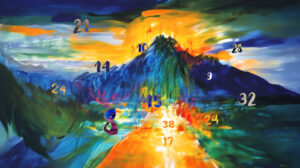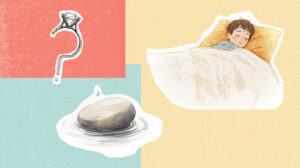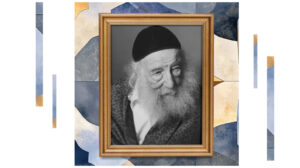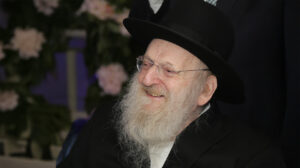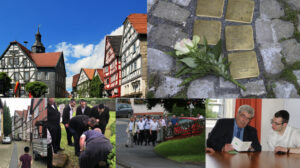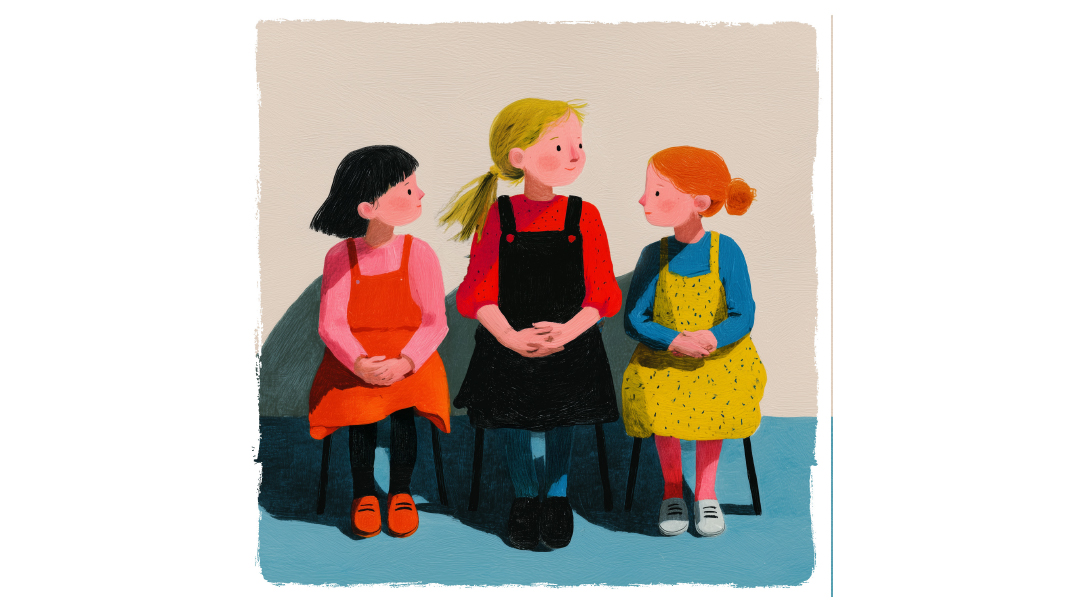Sweetening the Bitter Waters
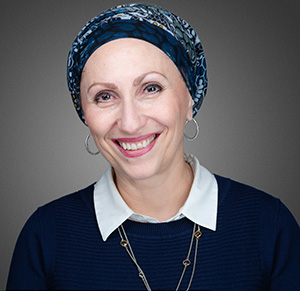
They faced the unthinkable twice,and then the Holmans turned grief into giving
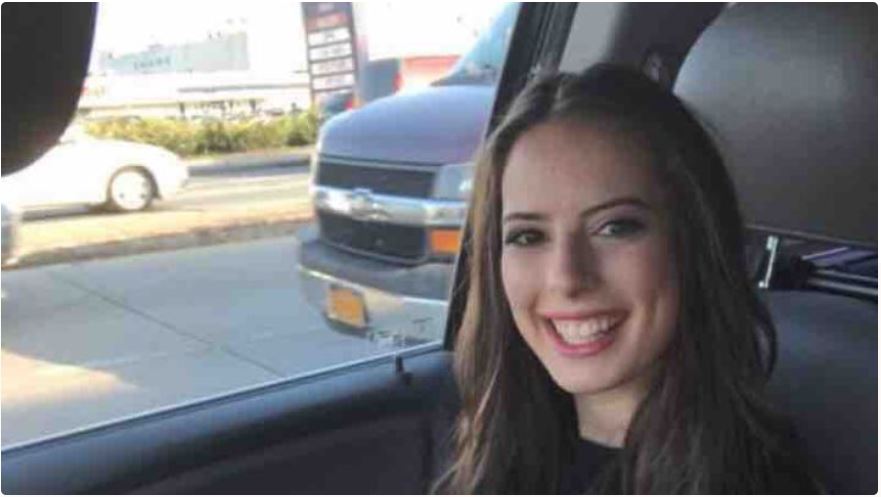
Sometimes Hashem sends tests that are excruciatingly painful. Yet in the case of certain people, they bring out strengths that no one, not even themselves, could ever have anticipated. The Holman family of Far Rockaway and their daughter Miriam a”h bear witness to this: They faced tremendous suffering and loss with faith and courage, and transformed their grief into initiatives to help others.
Miriam was nifteres on January 30, 2018 (14 Shevat 5778). The Holmans acknowledge that the name Miriam translates as “bitter waters.” Yet, like Miriam haNeviah, she took bitter waters and made them sweet for everyone around her. “She took what was bitter in her own life, and used it to reach out to others,” her father, Glen (Zelig Shaul) says.
Miriam had been deeply influenced by the family’s first bout of tragedy, over ten years earlier. In 1998, her sister, Nechama Liba, three years older than her, was diagnosed at age five with an extremely rare disease. After struggling for six years, Nechama Liba passed away three days before she turned 11.
“Nechama Liba was an old soul,” recalls Glen, who meets us at the home of his neighbor, Mishpacha writer Chaia Frishman. “Even when she was sick, she’d try to be b’simchah. She smiled just a few moments before she passed away. That was a driving example for Miriam when she became ill.”
“Nechama Liba was like a wise old woman in a child’s body,” Chaia concurs. “She was so mature, even regal, for a child.”
Nechama Liba’s death was a bitter loss, and as Glen and his wife Saguite struggled to pick up the pieces of their broken hearts, they were persuaded to attend a Chai Lifeline retreat that October. It was a powerful and beneficial experience, and when they returned, they found themselves wishing Nechama Liba’s siblings could have benefited from a similar experience.
They decided to organize an entire weekend for bereaved families, which became known as the Holman Family Retreat. They committed to raising all the funds and planning the entire weekend, A to Z, themselves. The weekends became a yearly event, and Miriam was always heavily involved in the planning.
Glen, who is trained as a licensed social worker specializing in bereavement, says those weekends are designed to accommodate a broad range of approaches to grief. “Grief is as individual as people are,” he explains. “Some people want to shut it out and not deal with it at all. If you try to force those people into therapy sessions, you’ll do more harm than good.”
The retreats offer plenty of fun, non-bereavement-centered activities, from motorcycle rides to art to Pirchei and Bnos groups and music. But those who want to speak about their feelings and receive guidance and empathy can participate in the therapeutic sessions.
A Special Neshamah
If Nechama Liba was the “old soul” of the Holman family, Miriam was its blithe spirit. Sweet, effervescent, smart, and stylish, she was what her father describes as a “nachas machine”— the type of child who, with minimal coaxing from her parents, seemed to effortlessly develop beautiful middos, excel in school, and make great friends (although Miriam had worthy role models in Glen and Saguite).
While Miriam had exceptional middos, she wasn’t “rebbetzin-y.” “She was a happy, fun, girly teenager,” Chaia recalls. “She loved clothing and bright lipstick and was the fashion maven for her friends.” Her fashion sense was just one expression of her artistic nature; Miriam loved to paint, and would get together with similarly inclined friends to spend afternoons painting or decorating cookies.
Friends and teachers remember Miriam as a warm, cheerful girl ever ready to help out, a girl who got along with everybody and was a pleasure to teach.
When Miriam finished high school, she enrolled in Seminar in Jerusalem. The family packed her up happily, but their joy was short-lived. At Succos time, she developed what seemed to be pneumonia and was hospitalized in Shaare Zedek Hospital. But she wasn’t getting better, even as the weeks passed.
Glen flew out to be with her. It soon became clear that she would have to abandon her dream of seminary. She’d been diagnosed with a rare form of pulmonary hypertension (high blood pressure in the arteries of the lungs) for which there is no medical cure, and which is terminal without a lung transplant.
Powering Ahead
Despite the horrifying diagnosis, when Miriam came home, she had no intention of giving up and retiring to her bed to wait out her time.
“It was like a switch was flipped on,” Glen relates. “She suddenly turned into this very strong person — almost fierce! Instead of retreating, she threw herself into every area of life, aware she was living on borrowed time.”
On other occasions, she drove people home from simchahs even when it meant going miles out of her way, and even when she was bone tired.
Miriam enrolled in a program at Touro College to become an ultrasound technician. She wanted to specialize in heart issues, in order to help others. Her friends were beginning to date, and it must have been extremely painful to know she was excluded from that due to her medical condition.
She drove back and forth to Flatbush, and worked on the side for a popular local physical therapist and the One Israel Fund. She taught computers in a Bais Yaakov and occasionally helped the Frishmans manage the books for their fruit platter business. On top of all that, she continued to do the lion’s share of the organizing for the Holman Family Retreats.
She pulled it all off while dealing with medications and various medical apparatuses. She was extremely organized. The Holman retreats require months of planning: sleeping and seating arrangements, meals, and activities. Each weekend includes a siyum Mishnayos, and Miriam would make the calls to solicit volunteers to learn. She set up a WhatsApp chat for bereaved siblings and gave chizuk to them. When a friend who’d lost a sibling confessed to going through a hard time, Miriam told her, “It’s okay to feel mad at Hashem sometimes. It doesn’t take away from being frum.”
Miriam would occasionally gather the girls from the retreat for a night out at a restaurant, or drive with them to a wedding or simchah one of the participating families was making. But she wanted organized year-round programs for the suffering siblings. Shortly before her last hospitalization, she and her father decided to develop such an organization, but Hashem had other plans.
Although Miriam looked like herself, she couldn’t walk very far and would become winded quickly. She was able to drive, though, and while eligible for a handicap license plate, refused to apply for one. In fact, when a friend going to class called to complain about having trouble finding a parking spot, Miriam — who was also driving to school — told her, “If I find one, I’ll give it to you.”
Miriam threw herself into everyone else’s dating, becoming her friends’ mentor and confidante (they knew she could always be trusted to keep a secret). She’d advise friends what to wear on dates, and lend them her own clothes if they couldn’t find anything satisfactory in their closets. After her death, a gemach was established l’ilui nishmasah for girls who need shidduch clothing.
As her friends began to marry, she always came to their weddings, even when they were a long drive away, in Monsey or Lakewood. “She lived for those events,” Glen says. “She approached life with more energy than many people who are healthy.” She expressed her attitude by changing her WhatsApp status to read: “You miss 100 percent of the shots you don’t take.”
Valley of Shadows
After Miriam became ill, she wanted to visit gedolim to receive brachos for a yeshuah. She took it upon herself to travel alone to Eretz Yisrael. She required supplementary oxygen on the plane, but she persisted and managed to travel to many gedolim. One of them told her, “You came to me for chizuk. But I’m getting chizuk from speaking to you!”
“She had tremendous yiras Shamayim,” remembers Rebbetzin Aviva Feiner, who calls Miriam one of her favorite talmidos. “I remember the times she came to my husband with sh’eilos, and the three of us would sit around our dining room table and talk. She was very sick, but she was so careful with halachos, and so sensitive to her friends and family.”
Knowing that the future was uncertain and likely to get darker, she also resolved to start ticking items off her bucket list. “She didn’t want to be the ‘sick kid,’ ” Glen says. “Last August, she went horseback riding. She did indoor skydiving. She’d always had a dream to swim with dolphins, and during last summer my wife went with her to the Bahamas so she could do so.”
The last five months of her life were spent in Columbia Presbyterian Hospital. “It was a roller coaster,” Glen says. “Every time we’d have reason for encouragement, something would go wrong. But Miriam just kept forging ahead.”
This time was extremely challenging for Miriam and her entire family. She entered the hospital in September; by October, she’d deteriorated to the point where she needed to be on an ECMO machine to stay alive. Her case was so complex that the ECMO had to be configured in a manner never tried before, and she had the dubious honor of being one of the hospital’s longest-surviving patient on ECMO.
When the staff would take her for a walk in the hallway, she needed six or seven people with her to handle all her machines. It became clear that only a double lung transplant could save her life.
The competition for organs is fierce, with laws dictating where they can be sourced from. Glen took those statutes to court to challenge the boundaries and won his battle to expand the possibilities for his daughter. Yet Miriam’s rare blood type, AB, made it harder to find a match.
Finally, word came: lungs were available! “When you’re going for a transplant, they call you and right away you’re up and out,” Glen explains.
“Miriam was very emotional; for the first time, she started crying. It was a Friday night. As they began wheeling her out of her room, we passed a frum family in the hall. Despite her own frightening situation, she looked at them and wished them a good Shabbos.”
When a nurse came out to tell them the operation had been successful, “we all bawled,” Glen says.
But in some ways, the post-op situation was even harder for Miriam. She wasn’t able to move at all, beyond shifting her eyes and head a bit. Attached to a respirator, she could only mouth words. (The family had tried an eye-gaze device to allow her to express herself, but it wasn’t effective.)
On Motzaei Shabbos, knowing her friend Adina would be running in the Chai Lifeline marathon in Florida the following day, Miriam mouthed to her mother to put in a FaceTime call to her. Miriam mouthed, “Go, Adina!” and blew her a kiss. “She had nothing left, yet she was still giving people chizuk,” Glen marvels.
“It is difficult to be mechadesh kochos in hospitals,” he declares. “Complainers continue to complain; giving people are still giving.” Miriam’s essence — her focus on others, her compassion and positivity — remained even when she was at the end of medical science’s ability to help her.
The transplant went well, but Hashem decreed it should not be the solution. Shortly afterwards, Miriam contracted sepsis. To the dismay and grief of the entire community, her weakened body succumbed to the infection. Levayahs were held both in the US and in Eretz Yisrael, where she was buried.
After her death, her family committed to carry on and fulfill her dream. Forming an organization, Mayrim, to support families who had lost children seemed the most logical step to take in Miriam’s memory. Mayrim means to “lift up,” and provides events and support services year round for these families. Programs include local support groups, with special focus on bereaved siblings — they have BBQs, Melaveh Malkahs, parent panels, and art therapy.
Best Friends Forever
Sometimes tragedies intertwine in ways so uncanny that it seems a clear hint from Hashem that He really does have everything perfectly and precisely planned — even though it’s so terribly painful for those left behind.
The Holman family went to Eretz Yisrael that year for Pesach, and to put up Miriam’s matzeivah. Over Chol Hamoed, they received a horrifying piece of news: Miriam’s neighbor and best friend, Elisheva Kaplan, and her chassan, Yisroel Levin, had perished in a terrible car accident. “I have some very bad news for you, but it’s not about anyone in the family,” Glen and Saguite told their youngest daughter, Malka. When she heard the news, Malka burst into tears. “You lied!” she cried. “Elisheva is our family!”
“I cried only twice during Miriam’s shivah,” Glen say. “One of them was when Mrs. Kaplan walked in.”
The connection between the Kaplans and the Holmans ran much deeper than being next door neighbors. Miriam and Elisheva used to take walks together every Friday night. The Kaplan family felt so strongly that Miriam was part of their family that they used to jokingly say her name was really “Miriam Kaplan.” Elisheva’s grandfather called her “my granddaughter who I’m not allowed to kiss.” When Elisheva became engaged, the couple came to the Holmans for a mazel tov as soon as they finished the l’chayim with their parents.
When Miriam was nifteres, Elisheva continued to visit the Holman house on Friday nights, just as she’d always done, to give comfort to the family. During the shivah, she wrote to Miriam in a shivah notebook: “I miss you so much and can’t wait to be reunited with you when Mashiach comes.” When Elisheva was nifteres, her father, Joel Kaplan, shared at the levayah that it was comforting to know that Elisheva was now reunited with her best friend and neighbor, Miriam.
Strangely enough, the Holmans also had a longstanding connection to the family of Elisheva’s chassan, Yisroel Levin. The two families had spent time in the same bungalow colony years earlier. Their son Eli, a singer, sang for Miriam when she was in the hospital, and their other son, Shmuel David, had worked as a volunteer at the Holman Retreats. Yisroel had been in Eretz Yisrael when Miriam was nifteres and attended the levayah, and afterwards wrote the Holmans a long, moving letter about how inspired he was by Miriam’s life.
There are many strange coincidences in the dates of these tragic events. The Levins had another son who was also niftar; he passed away exactly two years before Miriam. The yahrtzeit of Yisroel Levin and Elisheva Kaplan is the exact same Hebrew date as Miriam’s birthday. There’s yet one more coincidence: the Kaplans’ married son and his wife lost their baby Shlomo to crib death, and the baby’s birthday was the same date as Miriam’s yahrtzeit.
Moving Forward
“Losing a child is huge. It’s inevitable that it will change you,” Glen says. “You might become more callous or more compassionate; you might need to throw yourself into distractions. During moments like Jewish holidays or family simchahs, you’ll very much feel the absence of your family member.”
Some people try to preserve the connection to their loved one by talking about them endlessly, or by drowning in grief. Glen doesn’t believe in suppressing grief, but also believes in trying to move on. “I’ll sometimes suggest to other bereaved parents to let those feelings visit. But you don’t have to let them control your entire life,” he says.
It’s constructive to preserve your connection to a lost loved one by doing things that would be meaningful to the niftar. For Glen, that means speaking about his departed daughters and doing crisis work, shalom bayis and bereavement counseling, bikur cholim, volunteer work, and running the Holman retreats.
“Every mitzvah a bereaved parent does is so meaningful,” Glen says. “It’s a way of saying, ‘Hashem, even though You took my child, I’m still connected to You.’ It’s easy to have emunah when life is good. The heroes are those people who went through loss and still held on to their faith.”
Miriam set the example for all of us. “She wasn’t helping people in spite of her situation,” Glen says. “She helped people because she knew just how painful their situations were. That was the gas in her car. That was how she took bitter waters and made them sweet.”
The Bereavement Process
“Trying to explain bereavement to someone who hasn’t been there,” says Glen, “is like trying to describe the color red to someone who’s color blind.”
Reactions to loss span the gamut from stoicism to being completely blindsided by the trauma. Psychologist Elizabeth Kubler Ross, working with terminal patients and their families, posited that there are five stages of grief: denial, anger, bargaining, depression, and acceptance.
Since her pioneering work, On Death and Dying, others have been added in stages such as shock, pain, guilt, and working through. Yet all bereavement experts caution that people don’t necessarily progress in a linear, predictable fashion through these stages. “Grief is very personal; each one of us is entitled to his own schedule,” writes Dr. David B. Feldman in Psychology Today. “It’s not a race to the finish line.”
Glen acknowledges that he saw tremendous differences in the way his children handled the loss of a sibling. “Some didn’t want to discuss it at all, while others were interested in talking about Miriam,” he says. After Nechama passed away, Miriam threw herself into helping plan the Holman Family Retreats, while some of the others floundered.
It’s common for spouses to have different styles of mourning, and often they conflict. Glen gives some examples: “One may want to put lots of pictures of their child on the wall, while the other wants to take them down,” he says. “One may feel his life is over while the other soldiers on, or becomes obsessed with the idea that Mashiach is coming. Some couples in mourning are holding onto their relationship by a thread.”
Miriam once had the idea to create a photo book during the family retreats, with pictures of their deceased children. Although most people found it meaningful, not everyone warmed to the idea. One family in particular resisted for a long time, but finally Miriam was able to persuade them.
“In the end it was beautiful, and they were really happy they did it,” Glen says. He pauses. “During the last retreat, Miriam was making those books. Now, she’ll be a page in one.”
Forever in My Heart
By Malka Holman, Miriam’s younger sister
I’ve never experienced anything close to the pain I felt that day, the day that my sister, Miriam, passed away. Our relationship wasn’t a normal sibling relationship, it was something so much more special than that.
On the day she died, I was home from school. My neighbor came and told me we were going to the hospital because Miriam wasn’t feeling well. As I rushed to my neighbor’s car, my heart was pounding loudly. The whole way to the hospital, thoughts were racing through my mind. Was Miriam going to be okay? Why was no one telling me anything? What was happening?
After what felt like the longest car ride ever, we finally arrived at the hospital. I saw my father. His eyes were clouded in darkness. I rushed over to him. Anxiously, I asked him what had happened. He kneeled down, looked me in the eyes, and asked me what I thought had happened. I felt overpowered by my emotions, so I just shrugged. I didn’t want to say it, but deep down I felt that Miriam was gone.
My father then confirmed what I’d been thinking. Miriam had passed away.
Everything went black. I could barely breathe and was weak in my knees. I walked out of that hospital lobby knowing I’d never be the same again.
I couldn’t think straight. How would I live without Miriam? How would I get through all the hard times ahead when my sister wouldn’t be by my side?
Shivah is a very overwhelming and painful thing to experience. All my memories of Miriam came flooding back; every smile, every laugh, every tear. I didn’t think I’d be able to survive. Although it was just a week, it felt like an eternity.
Although it’s extremely difficult for me to accept that I’ll never see Miriam again, I know that with time I’ll slowly feel less and less sad. I miss her so much and think about her constantly. She’ll forever be in my heart.
(Originally featured in Family First, Issue 727)
Oops! We could not locate your form.

